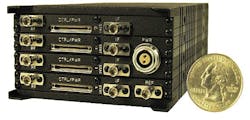DRS unveils next-generation RF and microwave digital and analog tuners aimed at UAV applications
MERRIMACK, N.H., 27 Oct. 2014.RF and microwave experts at the DRS Technologies Inc. Signal Solutions segment in Merrimack, N.H., are moving VHF and UHF wideband tuner technology forward with the introduction of the company's Polaris tuner for cognitive radio, spectrum monitoring, signals intelligence, direction finding, and beam forming.
The Polaris small power tactical radio frequency tuner, which is aimed at unmanned aerial vehicles (UAVs), weighs less than 2.5 pounds and fits in the palm of the hand. It uses little power and is designed to operate in harsh environments and in wide temperature ranges, company officials say.
The Polaris RF tuner comes in analog or digital format and can withstand the rigors of high-altitude flight in unmanned aerial vehicles, officials say.
Related: 200-Watt limiter for air traffic management and radar systems introduced by M/A-COM
The SI-9150/A4 Polaris multi-channel wideband analog tuner has a frequency range of 2 to 6,200 MHz and has tuning resolution of 1 MHz. Its tuning speed is 300 microseconds.
The tuner's four-channel configuration measures 3 by 5 by 1.65 inches, weighs 2.25 pounds, and takes input power of 8 to 16 volts DC. The unit operates in temperatures from -40 to 70 degrees Celsius and operates at altitudes as high as 50,000 feet. The tuner meets MIL-STD-810F MIL-STD-461E.
The SI-9150/D4 Polaris multi-channel wideband digital tuner has a frequency range of 2 to 6,200 MHz and has tuning resolution of 1 MHz. Its tuning speed is 300 microseconds.
Related: Navy researchers choose specialized RF and microwave test equipment from Zeta Associates
The tuner measures 3 by 5 by 2.51 inches, weighs 3.7 pounds, and takes input power of 30 Watts maximum. The unit operates in temperatures from -40 to 70 C and can operate at altitudes as high as 50,000 feet. Like its analog cousin, the SI-9150/D4 Polaris meets MIL-STD-810F MIL-STD-461E.
The Polaris is the next-generation of RF front ends, enhanced from its DRS Nanoceptor predecessor, company officials say. “The Nanoceptor was the gold standard in ruggedized RF tuners in 2004, and now Polaris will be breaking new ground and raising the bar even higher,” says Steve Robillard, vice president of business development at DRS Signal Solutions.
For more information contact DRS Signal Solutions online at www.drs.com/Polaris.

